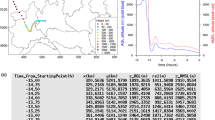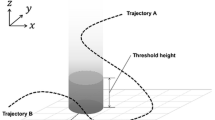Abstract
This study applies backward trajectory-based statistical techniques, residence time, conditional probability and emission attraction to evaluate potential source regions of PM10 over a coastal region. PM10 episodes were selected by principal component analysis for 1998–2005 over the Kaoping air quality basin. Residence time was applied to identify potential regions in which air parcels would remain over their 6- and 12-h trajectories. Emission attraction and conditional probability were used to analyze contribution ratios of distinct emission sources to air quality stations. The PM10 episodes screen 175 days (6 % of total days) and 35.9 % of total station numbers. Residence time and emission attraction clearly identified potential areas in which backward trajectories remained during PM10 episodes and high PM10 events. Emission attraction evaluated relative contributions of various sources (stationary, line, and area) from specific jurisdictions, and provided information on specific sources for high-priority PM10 emissions reduction. The conditional probabilities of emission attraction during high PM10 events show that high values concentrated near stationary and area sources in the city of Kaohsiung.






Similar content being viewed by others
References
Ashbaugh, L. L. (1983). A statistical trajectory technique for determining air pollution source regions. Journal of the Air Pollution Control Association, 33, 1263–1270.
Ashbaugh, L. L., Malm, W. C., Sadeh, W. Z., et al. (1985). A residence time probability analysis of sulfur concentrations at Grand Canyon National Park. Atmospheric Environment, 19, 1263–1270.
Barnes, S.L. (1973). Mesoscale objective map analysis using weighted time series observations. NOAA Tech Memo, ERL NSSL-62, 60 pp.
Begum, B. A., Biswas, S. K., Markwitz, A., Hopke, P. K., et al. (2010). Identification of sources of fine and coarse particulate matter in Dhaka, Bangladesh. Aerosol Air Quality Resarch, 10, 345–353.
Chang, K. H. (2008). Modeling approach for emission reduction of O3 precursors in Southern Taiwan. Atmospheric Environment, 42, 6733–6742.
Chang, L. F. W., Hwang, R. R., Lin, S. C., et al. (1983). A variation-kinematic model for flow over complex terrain. Annual Report of the Institute of Physics Academia Sinica, 13, 89–102.
Chen, T. F., & Chang, K. H. (2006). Formulating the relationship between ozone pollution features and the transition value of photochemical indicators. Atmospheric Environment, 40, 1816–1827.
Cheng, M. D., Hopke, P. K., Zeng, Y., et al. (1993). A receptor-oriented methodology for determining source regions of particulate sulfate at Dorset, Ontario. Journal of Geophysical Research, 98, 16839–16849.
Cheng, M. D., Hopke, P. K., Barrie, L., Rippe, A., Olson, M., Landsberger, S., et al. (1993). Qualitative determination of source regions of aerosol in Canadian high Arctic. Environmental Science and Technology, 27, 2063–2071.
Comrie, A. C. (1994). Tracking ozone: air mass trajectories and pollutant source regions influencing ozone in Pennsylvania forests. Annals of the Association of American Geographers, 84, 635–651.
Gao, N., Cheng, M. D., Hopke, P. K., et al. (1993). Potential source contribution function analysis and source apportionment of sulfur species measured at Rubidoux, CA during the southern California air quality study, 1987. Analytical Chimica Acta, 277, 369–380.
Held, T., Ying, Q., Kaduwela, A., Kellman, M., et al. (2004). Modeling particulate matter in the San Joaquin Valley with a source oriented externally mixed three-dimensional photochemical grid model. Atmospheric Environment, 38, 3689–3711.
Kleemana, M. J., Ying, Q., Lu, J., Mysliwiec, M. J., Griffin, R. J., Chen, J., Cleg, S., et al. (2007). Source apportionment of secondary organic aerosol during a severe photochemical smog episode. Atmospheric Environment, 41, 1521–1538.
Lin, C. H., Wu, Y. L., Chang, K. H., Lai, C. H., et al. (2004). A method for locating influential pollution sources and estimating their contributions. Environment Modeling and Assessment, 9, 129–136.
Munn, R. E., Likens, G. E., Weisman, B., Hornbeck, J. W., Martin, C. W., Bormann, F. H., et al. (1984). A meteorological analysis of the precipitation chemistry event samples at Hubbard Brook (N.H.). Atmospheric Environment, 18, 2775–2779.
Poirot, R. L., & Wishinski, P. R. (1986). Visibility, sulfate and air mass history associated with the summertime aerosol in northern Vermont. Atmospheric Environment, 24A, 2059–2069.
Poissant, L. (1999). Potential sources of atmospheric total gaseous mercury in the St. Lawrence river valley. Atmospheric Environment, 33, 2537–2547.
Sasaki, Y. (1958). An objective analysis based on the variational method. Journal of the Meteorological Society of Japan, 36, 77–88.
Seibert, P., Kromp-Kolb, H., Baltensperger, U., Jost, D. T., Schwikowski, M., et al. (1994). Trajectory analysis of high alpine air pollution data. In S. E. Grying & M. M. Millan (Eds.), Air pollution modeling and its application X (pp. 595–596). New York: Plenum.
Silibello, C., Calori, G., Brusasca, G., Giudici, A., Angelino, E., Fossati, G., Peroni, E., Buganza, E., et al. (2008). Modeling of PM10 concentrations over Milano urban area using two aerosol modules. Environmental Modeling Software, 23, 333–343.
Stohl, A. (1996). Trajectory statistics−a new method to establish source–receptor relationships of air pollutants and its application to the transport of particulate sulfate in Europe. Atmospheric Environment, 30, 579–587.
Stohl, A., & Kromp-Kolb, H. (1994). Origin of ozone in Vienna and surroundings, Austria. Atmospheric Environment, 28, 1255–1266.
Taiwan Environmental Protection Administration. (2007). Taiwan Emission Database System (version 6.1).
Tsai, J. H., Hsu, Y. C., Yang, J. Y., et al. (2004). The relationship between volatile organic profiles and emission sources in ozone episode region—a case study in Southern Taiwan. Science of the Total Environment, 328, 131–142.
Virkkula, A., Makinen, M., Hillamo, R., et al. (1995). Atmospheric aerosol in the Finnish Arctic: number concentrations, chemical characteristics and source analysis. Water, Air, and Soil Pollution, 85, 1997–2002.
Xie, Y. L., Hopke, P. K., Paatero, P., Barrie, L. A., Li, S. M., et al. (1999). Locations and preferred pathways of possible sources of arctic aerosol. Atmospheric Environment, 33, 2229–2239.
Ying, Q., & Kleeman, M. J. (2006). Source contributions to the regional distribution of secondary particulate matter in California. Atmospheric Environment, 40, 736–752.
Ying, Q., Fraser, M. P., Graffin, R. J., Chen, J., Kleeman, M. J., et al. (2007). Verification of a source-oriented externally mixed air quality model during a severe photochemical smog episode. Atmospheric Environment, 41, 1521–1538.
Yu, T. Y., & Chang, L. F. W. (2000). Selection of the scenarios of ozone pollution at southern Taiwan area utilizing principal component analysis. Atmospheric Environment, 34, 4499–4509.
Yu, T. Y., Lin, C. Y., Chang, L. F. W., et al. (2012). Estimating air pollutant emission factors from open burning of rice straw by the residual mass method. Atmospheric Environment, 54, 428–438.
Zeng, Y., & Hopke, P. K. (1989). A study of acid precipitation in Ontario, Canada. Atmospheric Environment, 23, 1499–1509.
Acknowledgments
The work was supported by the Research Grant contract NSC 93-2211-E-267-003 from the National Science Council, Taiwan
Author information
Authors and Affiliations
Corresponding author
Rights and permissions
About this article
Cite this article
Yu, TY. Identification of source regions of PM10 with backward trajectory-based statistical models during PM10 episodes. Environ Monit Assess 185, 6465–6475 (2013). https://doi.org/10.1007/s10661-012-3038-6
Received:
Accepted:
Published:
Issue Date:
DOI: https://doi.org/10.1007/s10661-012-3038-6




